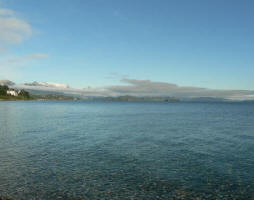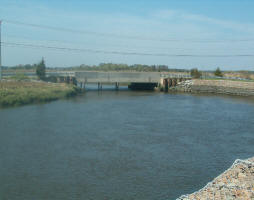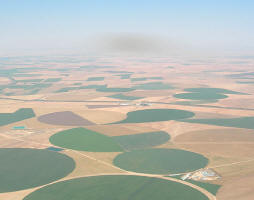 New version of SEI’s water planning software links easily to energy tool for ‘nexus’ analyses, adds IWMI environmental flow assessment module
New version of SEI’s water planning software links easily to energy tool for ‘nexus’ analyses, adds IWMI environmental flow assessment module
The latest enhancements to the Water Evaluation and Planning (WEAP) system, used by thousands of governments, researchers and non-profits in 170 countries, were showcased at World Water Week in Stockholm last week. WEAP 3.3 is available for download today, free to developing-country users.
Water is a vital resource, essential to human activities and ecosystems alike. Around the world, it is in ever-greater demand, but it is also increasingly scarce, and climate change threatens to make the situation much worse. Thus it is crucial to manage water resources wisely – and to plan carefully for an uncertain future. That is the purpose of WEAP, which SEI has offered, and continuously improved, for two decades.
The latest version of WEAP, unveiled at a side-event August 30 at World Water Week, adds new capabilities to explore so-called “nexus” issues, most notably a seamless link to SEI’s Long-range Energy Alternatives Planning (LEAP) software. Used together, the two systems can model evolving conditions in both water and energy systems and show the cross-sectoral impacts of different policy choices.
For example, WEAP users can import information from LEAP to see how hydropower demand in a region might change over time, or how thermoelectric power plants’ cooling-water needs might increase as summers get hotter due to climate change. They can also link with LEAP to see how energy consumption and greenhouse gas emissions from the water sector might change if, for example, they chose to desalinate seawater or clean and reuse wastewater instead of importing water that is pumped across long distances.
“With this new dynamic linkage to SEI’s LEAP energy planning software, WEAP modelers can now create much more powerful and integrated models to explore both the impact of the energy system on the water system as well as the water system’s impact on the energy system,” says Jack Sieber, developer of WEAP and a senior scientist in SEI’s U.S. Centre in Somerville, MA.
The linkage is a result of a two-year project funded by the U.S. National Oceanic and Atmospheric Administration (NOAA) Sectoral Applications Research Program, which is also supporting the first application of the linked tools, a case study of the potential impacts of desalination in Southern California.
California’s recently established Water-Energy Team is also considering applications of the WEAP-LEAP framework. In addition, the World Bank plans to deploy WEAP-LEAP as part of an initiative to bring its water and energy investment planning teams together to ensure their efforts complement each other.
“While much work has gone into developing the conceptual framework for exploring the water-energy nexus, until now we had not produced a good integrated tool to make these concepts operational,” says David R. Purkey, director of the SEI-US Water Group in Davis, Calif. “The WEAP-LEAP integration is an exciting step towards providing such a tool, with the added advantage that it is derived from fully functional, and globally renowned, water and energy planning platforms.”
The new version of WEAP also adds a new function and wizard to help estimate and model environmental flows, incorporating the methodology of the Global Environmental Flow Calculator (GEFC), which was developed by the International Water Management Institute (IWMI). This addresses a different set of “nexus” issues – the need to ensure that sufficient water is provided to support healthy ecosystems.
“We believe that adding the IWMI module will not only expand WEAP’s capabilities, but will also promote the concept and practice of environmental water allocation in river basin planning and management,” says Vladimir Smakhtin, director of the Research Program on Water Availability and Access at IWMI.
WEAP also includes several other features that make it significantly more powerful and easier to use:
• Interactive wizard for exploring, comparing and selecting individual time series from one or more CSV text files.
• Numerous optimizations to speed up calculations and display for both data and results.
• Structural changes to WEAP’s built-in linear program (LP) solver increases its robustness, and allows for solving much more complex models.
• Several new result reports and additions to WEAP’s powerful Application Programming Interface (API)
In addition, now that the WEAP website has been translated into 21 languages, SEI will be working with partners and volunteers to add new language translations to the WEAP software in the coming months.
SEI distributes WEAP free of charge to governments, universities, and not-for-profit organizations in the developing world. Consulting companies, utilities and other businesses can also access the tools through affordably priced licensing arrangements. To learn more or to download WEAP, visit www.weap21.org.
We have also compiled a factsheet on the WEAP-LEAP linkage, and a policy brief describing an application of the tool, to examine the energy and climate implications of desalination in Southern California. In addition, we have several WEAP-related videos on our website from World Water Week.
--
About
the Stockholm Environment Institute
The Stockholm
Environment Institute (SEI) is an international non-profit research organization
that has been engaged in environment and development issues at the local,
national, regional and global policy levels for more than 20 years. Its goal is
to bring about change for sustainable development by bridging science and
policy. SEI has seven centres worldwide, in Stockholm; Oxford and York, U.K.;
the United States; Bangkok, Thailand; Dar es Salaam, Tanzania; and Tallinn,
Estonia. WEAP, which is used in 170 countries worldwide, was developed in and is
supported by SEI’s U.S. Centre.
| Contact information |
Jack Sieber – WEAP developer / David R. Purkey – U.S. Water Group director / Anna Löfdahl – Press and Communications Adviser
(email: jack.sieber@sei-us.org ; david.purkey@sei-international.org ; anna.lofdahl@sei-international.org) Phone: +1 (617) 627-3786 x4# / +1 (530) 753-3035 x1# / +46 8 674 7693 (in Stockholm) |
|---|---|
| News type | Inbrief |
| File link |
http://www.weap21.org |
| Source of information | The Stockholm Environment Institute (SEI) |
| Keyword(s) | WEAP, water-energy nexus |
| Subject(s) | AGRICULTURE , ENERGY , HYDRAULICS - HYDROLOGY , INFORMATION - COMPUTER SCIENCES , MEASUREMENTS AND INSTRUMENTATION , METHTODOLOGY - STATISTICS - DECISION AID , NATURAL MEDIUM , POLICY-WATER POLICY AND WATER MANAGEMENT , RISKS AND CLIMATOLOGY , WATER DEMAND |
| Relation | http://www.sei-international.org/publications?pid=2149 |
| Geographical coverage | Sweden, |
| News date | 06/09/2012 |
| Working language(s) | ENGLISH |
 you are not logged in
you are not logged in





